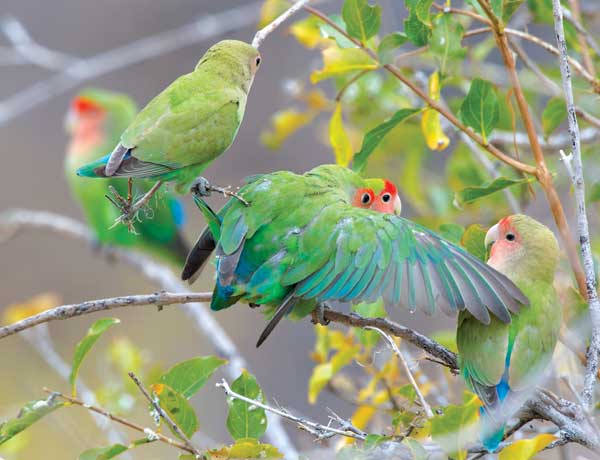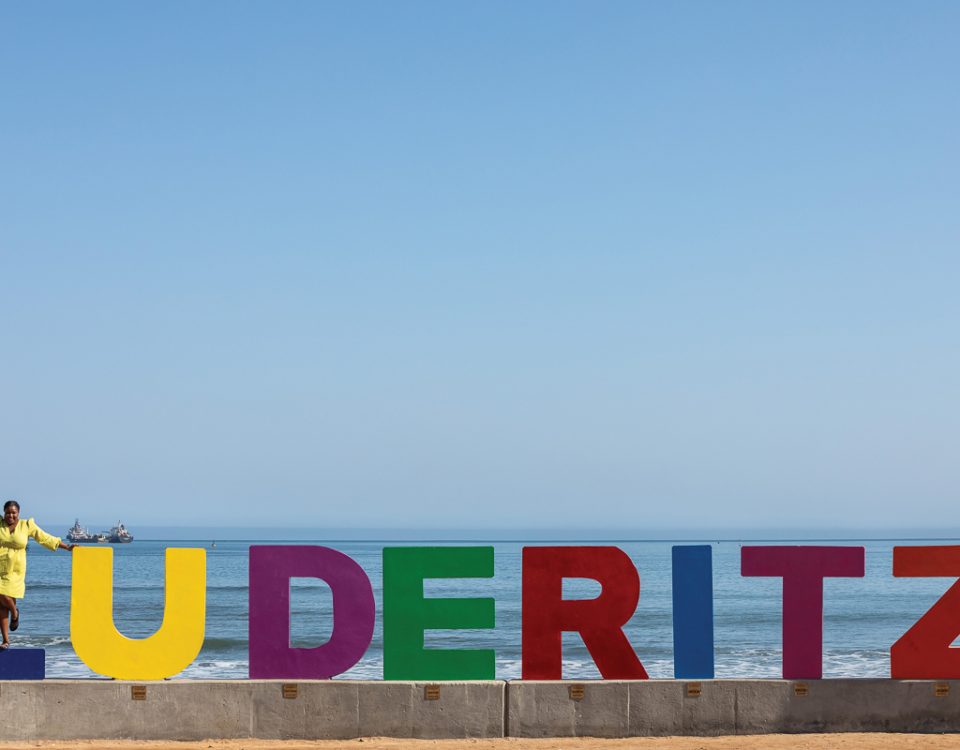
News | Kalahari Sands Hotel Re-brands to Avani
July 21, 2015
Battling invasive cacti
September 3, 2015To every season there is a turn.
Text & Photographs Pompie Burger
I am colour-blind. That is what Helga, my wife, thinks. If I happen to put on a green shirt and trousers (no, I do not have green trousers or shirts, only blue ones) she will immediately say it does not match! Green is green and blue is blue, at least that’s what I thought, but apparently there are different greens and different blues. The reason why I make this wise and wonderful statement is that when Rièth said we need a green article I thought, ‘no problem, green is green, and there are lots of green birds’! Not so. Apart from the fact that there are only a few “green” birds in Namibia, the few that do occur are all fancy shades of green.

Rosy-faced Lovebird (Agapornis roseicollis). Photo ©Pompie Burger

African Pygmy Goose (Nettapus auritus). Photo ©Pompie Burger
A fter a lot of research into the deeper meaning and different types of green I came to the conclusion that green is not always green, so not all my green birds are – if you will allow me to say so – the correct colour. Indeed all the green birds I have identified over the past 30 years suddenly seem not so green. You get emerald green, olive green, citrine green, lemon green. In fact, at the end of my intensive research I came to the sad conclusion that there are very few “green” birds (this is now according to Helga, the colour expert). My long and interesting list of green birds shrunk by about 50% but the good news for all those colour-impaired people, like myself, is that I will add all my “green” bird pictures – no matter what the colour-blind fundi might say. If you agree with me enjoy them, if you don’t get lost.
When my long list of green birds turned out to be much shorter than I expected (with my greens added), I was amazed how few green birds we have in Namibia. I thought that would be the prevalent colour in birds, being tree sitters and grass sitters, both of which to my mind are green. The only three species of birds with green as the dominant colour are bee-eaters, parrots and sunbirds. In my opinion they are also among the most beautiful birds in the world, even though green is not my favourite colour!

Diderick Cuckoo (Chrysococcyx caprius). Photo ©Pompie Burger
After digging very deep into Roberts Bird Guide I found the odd other green birds: those with the green spots, green stripes, green legs, green windows (speculum feathers) and my own “green” birds. The odds and ends regarding other green birds are the Green Wood Hoopoe (Phoeniculus purpureus), Narina Trogon (Apaloderma narina), Schalow’s Turaco (Tauraco schalowi), Allen’s Gallinule (Porphyrio alleni), African Purple Swamphen (Porphyrio madagascariensis), Diederick Cuckoo (Chrysococcyx caprius), Yellow-bellied Greenbul (Chlorocichla flaviventris), Grey-backed Camaroptera (Camaroptera brevicaudata) and Green-winged Pytilia (Pytilia melba). Maybe we have so few green birds because Namibia is not the greenest country in the world?
To add to the spectrum of green bird species (somehow all the green birds are spectacularly coloured in addition to the green), the parrots are not only green and spectacular but also very vocal and musical. Grey-headed Parrots (Piocephalus cryptoxanthus), Meyer Parrots (Piocephalus meyeri) and Rosy-faced Lovebirds (Agapornis roseicollis) are three of the more spectacular parrot species occurring in Namibia. Two of our dove species sport some green: the African Green Pigeon (Treron calvus) is completely green (Helga does agree on this one), while the Emerald-spotted Wood Dove (Turtur chalcospilos) has a green (emerald) spot on its wing.
In our country the bee-eaters are by far the birds with the most green, among them the White-fronted (Merops bullockoides), Swallow-tailed (Merops hirundineus), European (Merops apiaster), Little (Merops pusillus), Madagascar (Merops superciliosus) and Blue-cheeked (Merops persicus) Bee-eater. In fact the Southern Carmine Bee-eater (Merops nubicoides) is the only member of this species in Namibia which has no green (not even my green).

Allen’s Gallinule (Porphyrio alleni). Photo ©Pompie Burger
The sunbirds are also generously endowed with green – in this case an iridescent green (another green!). The metallic appearance is an optical phenomenon caused by the structure of the feather cells and outer layers of keratin which interfere with the waves of sunlight. The sunbirds with green in their plumage are the Malachite (Nectarinia famosa), Collared (Hedydipna collaris), Shelley’s (Cinnyris shelleyi), White-bellied (Cinnyris talatala), Scarlet-chested (Chalcomitra collaris) and Marico (Cinnyris mariquensis) Sunbirds.
An interesting group of birds with a window or speculum in their wing are geese and ducks, for example the Cape Teal (Anas capensis), Yellow-billed Duck (Anas undulata), Egyptian Goose (Alopochen aegyptiaca), South African Shelduck (Tadorna cana) and Cape Shoveler (Anas smithii). Male African Pygmy Geese (Nettapus auritus) have a bright green neck and back which primarily seems to serve as a signal in courtship display.

Marico Sunbird (Cinnyris mariquensis). Photo ©Pompie Burger

Little Bee-eater (Merops pusillus). Photo ©Pompie Burger

Grey-backed Camaroptera (Camaroptera brevicaudata). Photo ©Pompie Burger

Green-winged Pytilia (Pytilia melba). Photo ©Pompie Burger

Green-backed Heron (Butorides striata). Photo ©Pompie Burger
There are many wild and wonderful reasons why birds have specific colouration. My guess is that in this case (green) it is mostly for camouflage while sitting in trees and in the grass on the ground. Another reason for colour is display, i.e. just for show (to look beautiful).
Unfortunately none of the raptors have any green in their feather armour (on this one I could not convince Helga), so no raptors feature here this time. The idea with “green” in this edition is that spring is imminent with all its splendour and green… I still think a touch of brown would not be that bad (see raptors) even in spring, but I must admit green is fair enough considering that we can add all the bee-eaters and sunbirds. Interesting that none of the sunbirds and bee-eaters change their colour for the turn of the seasons. I suppose it is more difficult to change green pigments than the other ones.
We had joy, we had fun, we had seasons in the sun, but the stars we could reach where just starfish on the beach.
This article was first published in the Spring 2015 issue of Travel News Namibia.


